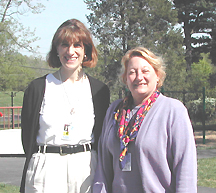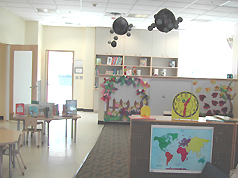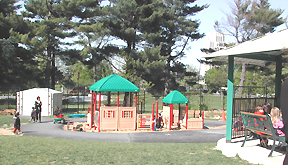
| T H E N I H C A T A L Y S T | M A Y – J U N E 2002 |
|
|
|
TAKING CARE OF CHILD CARE |
text and photos by Rashmi Nemade
|
 |
|
Enjoying
the day: (right) Mary Ellen Savarese, NIH child care specialist, with
Mary Haas, director, East Child Care Center
|
Lab space is important. So is money. And there’s no question that the caliber of the research and the scientists at NIH figure heavily in a decision to take a position here or to remain in one. But the one other issue that can make or break the deal, at least for many people with children, is the availability of child care—ideally on campus or, if not, at least close by, says Mary Ellen Savarese, NIH Child Care Programs specialist in the Office of Research Services (ORS).
The better to present real numbers when negotiating for more child-care resources, ORS engaged the services of Performance Dynamics, Inc. (PDI), and the University of Central Florida in Orlando to develop and conduct the Child Care Needs Assessment Survey.
First, to ascertain the kind of information ORS would seek, PDI created focus groups composed of child-care administrative staff, parents with children at each of the three Bethesda-based NIH child-care facilities (listed below), and even parents who work at NIH but have chosen other child- care services. A pilot survey was then administered online and questions further refined.
The final survey was offered in five languages online and two languages on paper. Survey results and the Executive Summary and Report were submitted in January 2002 and can be viewed at the website.
The survey was completed by 1,441 people out of the approximately 22,000 invited to participate—a 6.6 percent response rate, which is considered within the acceptable range in the field and deemed to adequately reflect the demographics of the NIH population as determined by the NIH Census collected in the year 2000.
The survey provided documentation of what most people at NIH might have intuited or extrapolated based on their individual experiences. As Savarese comments, "much of this was already known, but not in statistical terms.
 |
 |
|
Inside
. . .
|
.
. . and out, at the NIH East Child Care Center, adjacent to Natcher
|
Having the statistical data to support our requests for more resources is critical to maintaining the excellent quality of child care here—and to improving it further."
The survey concluded that:
![]() The need for child care greatly surpasses current capacity.
The need for child care greatly surpasses current capacity.
![]() A plan to assist employees with dependent-care needs should be developed.
A plan to assist employees with dependent-care needs should be developed.
![]() An income-based tuition assistance program should be developed.
An income-based tuition assistance program should be developed.
![]() The application procedures for all the existing centers should be standardized
and streamlined.
The application procedures for all the existing centers should be standardized
and streamlined.
The ORS Worksite Enrichment Programs Branch, under which child-care services and programs are offered, is working to address each of these issues.
Efforts are being directed to increase child care capacity by bringing licensed child care centers close to employees’ homes into the NIH system.
The Office of Personnel Management is exploring a Dependent Care Assistance Plan that will enable federal employees to set aside pre-tax dollars for such services as elder care and care for family members with special needs. Tuition assistance for low-income employees already exists in each center, but such funds are quite limited and the goal is to expand them.
| Two Empty Seats |
|
The
NIH
Child Care Board seeks two NIH employees to fill upcoming vacancies.
The board is advisory and advocates for affordable, high-quality child
care for the NIH community. Call Mary
Ellen Savarese, 402-8180, or visit the website. |
Until now, the enormous waiting list to obtain NIH childcare was infamous. Each center had its own waiting list, and parents wanting to obtain a spot would put their names on multiple lists. In collaboration with the Work and Family Life Center Referral Service, the ORS has now centralized this process.
"Now there’s
only one list," says Savarese, "and staff will be able to advise parents
of the wait and offer them alternatives all within one phone call. It’s
like one-stop shopping." The staff will also call employees on the waiting
list quarterly to update them on their list status and to assess their continuing
child-care needs. ![]()
|
Infant and Toddler Child Care Provider: ChildKind Inc. Ages served: 6 weeks–3 years Licensed capacity: 33 children Location: Building T-46 Hours of operation: 7:30 a.m.–6:00 p.m. (Monday–Friday; closed all federal holidays) Director: Lee Ettman, (301) 496-8357 Tuition: $494.00 every 2 weeks for children up to 2 years, $389.00 every 2 weeks for children 2–3 years Preschool Child Care Provider: Parents Of Preschoolers, Inc. Ages served: 2.5 years–6 years Licensed capacity: 105 children Location: Building 64 (East Child Care Center) Hours of operation: 7:30 a.m.–6:00 p.m. (Monday–Friday; closed all federal holidays) Director: Mary Haas, (301) 496-5144 Tuition: $110.00—$160.00 a week, on a sliding scale based on family income
OFF-CAMPUS Provider: Executive Child Development Center Inc. (ECDC) <http://www.nih.gov/od/ors/dss/special/ecdc.htm> Ages served: 6 weeks–12 years (before- and after-school care for older children) Licensed capacity: 220 children Location: Executive Boulevard, Rockville Hours of operation: 7:30 a.m.–6:00 p.m. (Monday–Friday; closed all federal holidays) Director: Anne Schmitz, (301) 496-9411 Tuition: sliding
scale based on family income: infants and toddlers: $424.00–$544.00
every 2 weeks; 2-year-olds: $332.00–$428.00 every 2 weeks; preschool
and kindergarten: $272.00–$350.00 every 2 weeks; kindergarten complement:
$15.00 a day; surround kindergarten: $254.00–$326.00 every 2 weeks;
before and after school: $178.00 every 2 weeks; after school only: $152.00
|